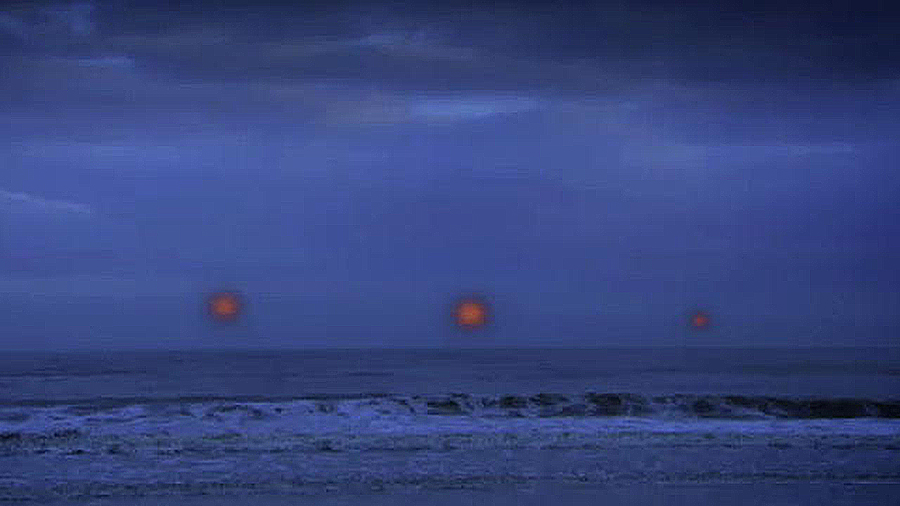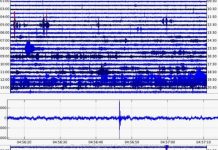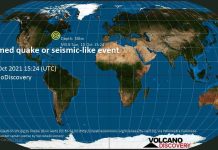
The so-called “Seneca Guns” have been mystifying residents of coastal North Carolina — and annoying scientists — for more than 150 years. No visible storm overhead, no nearby explosions, yet houses rattle, windows buzz, and pets absolutely lose it.
In recent years, researchers have tried to hunt these mystery booms with seismic stations and infrasound sensors, hoping to finally pin down their origin. Their latest findings were presented at AGU 2020 and, spoiler alert: the mystery continues. Of course it does. 😉
What are the “Seneca Guns”?
The name Seneca Guns doesn’t actually come from North Carolina at all. It traces back to Seneca Lake in upstate New York, where ominous booming sounds have been reported for centuries. The phenomenon was first described in 1850 by writer James Fenimore Cooper in his short story “The Lake Gun.”
“It is a sound resembling the explosion of a heavy piece of artillery, that can be accounted for by none of the known laws of nature. […] The report is deep, hollow, distant and imposing. The lake seems to be speaking to the surrounding hills, which send back the echoes of its voice in accurate reply. No satisfactory theory has ever been broached to explain these noises.”
Swap the lake for the Atlantic coastline of North Carolina and the description still fits. Residents regularly report deep, distant booms that feel like artillery or quarry blasts. Official explanations have ranged from distant storms, earthquakes, quarry explosions, military exercises or sonic booms, but none of these fully solve the puzzle.
What do the booms sound and feel like?
Witnesses along the Outer Banks, Cape Fear and surrounding areas describe:
- A single deep, hollow boom, like offshore artillery or a large explosion.
- Occasional rumbles and echoes that roll on for several seconds.
- Windows and doors rattling, sometimes with a brief shockwave-like jolt.
- No obvious thunderstorm overhead and no visible smoke, flashes, or explosions.
The new science about the Seneca Guns
To move beyond rumors and folklore, scientists compiled detailed reports of Seneca Guns incidents dating back to 2013 and created a catalog of observations: when people heard the booms, where they were, and how they described the events.
🔬 Scientific Findings: The UNC EarthScope Study
In 2020, a team of geologists from the University of North Carolina analyzed data from the EarthScope Transportable Array — a network of 400 seismographs and atmospheric sensors deployed across the eastern U.S. between 2013 and 2015 — to investigate the Seneca Guns mystery booms.
By comparing recorded signals with local news reports, they found several unusual acoustic events near Cape Fear, lasting from about 1 to 10 seconds. No corresponding earthquakes appeared in the seismic records, effectively ruling out ground shaking as the source.
The scientists concluded that the booms propagate through the atmosphere, not the crust, suggesting an atmospheric origin possibly linked to meteors, offshore thunder, ocean waves, or sonic booms.
They then compared those dates and times to data from the EarthScope Transportable Array, a network of ~400 seismographs and atmospheric sensors. The array is currently in Alaska, but it was deployed across the eastern U.S. — including North Carolina — between 2013 and 2015.
Key findings from the sensor network:
- Signals linked with the reported booms lasted from about 1 second to nearly 10 seconds.
- The station near Cape Fear picked up the clearest signals.
- The Cape Fear region is also where many Seneca Gun reports originate — not exactly a coincidence.
However, the array simply wasn’t dense enough to triangulate the exact source. The researchers could detect the “something big went boom” signature, but not nail down whether it started in the air, the ocean, or somewhere offshore. Translation: we need more instruments and more data before we can point a scientific finger at the culprit.
The Seneca Guns are not created by earthquakes
Because people often feel ground shaking when the booms hit, earthquakes were an obvious suspect. But when the team checked the seismic records, they found no earthquakes that lined up in time with the events.
That effectively rules out local earthquakes as the primary source of Seneca Guns. The ground may tremble, but whatever is causing the booms is probably not originating from deep below the crust.
The Seneca Guns are an atmospheric phenomenon
So if it’s not the ground, where does the noise travel? According to the researchers, the evidence points upward:
“Generally speaking, we believe this is an atmospheric phenomenon — we don’t think it’s coming from seismic activity, we’re assuming it’s propagating through the atmosphere rather than the ground. The data I’ve most focused on in this project is infrasound data rather than seismic,” lead researcher Bird told LiveScience.
In other words, these booms behave more like pressure waves in the air that sometimes couple into the ground and shake it, rather than classic earthquakes.
Possible explanations: meteors, waves, thunder or jets?
If the Seneca Guns are atmospheric, what could be driving them? Several candidates are on the table:
- Meteor fireballs – A bright bolide streaking in the upper atmosphere can produce rolling booms when its shockwave reaches the ground. Some researchers think fireballs could explain at least some events.
- Ocean-generated noise – Huge waves crashing, underwater landslides, or distant thunder over the Atlantic could launch powerful acoustic waves that travel inland.
- Sonic booms from high-speed aircraft – Military jets in the region have broken the sound barrier, meaning some “gun” reports are likely classic sonic booms.
- Something else entirely – Unmapped atmospheric ducts, strange propagation effects, or rare combinations of weather and ocean conditions could all be part of the story.
The catch? It’s probably not just one thing. Different events may have different origins, all lumped together under the same spooky nickname. If interested, here is a cse triage guide to determine the origins of mystery booms.
Still mysterious after 150+ years
For now, the explosive Seneca Guns remain a mystery. They sit on the long list of mysterious booms and rumblings reported worldwide — cousins to Sky Trumpets, hums and other strange acoustic outbursts from our restless planet.
The good news? If you live along the North Carolina coast and your house occasionally shakes from a distant “cannon blast,” you’re not alone. The bad news? Science still can’t tell you exactly why. Yet.
How Are Seneca Guns Different from Earthquake Booms?
While Seneca Guns are most likely atmospheric in origin, scientists have long documented another type of mysterious rumble known as earthquake booms. These occur during or immediately before shallow earthquakes, most often in the U.S. Northeast and East Coast.
The sound comes from P-waves (primary seismic waves) racing through rock faster than sound travels in air, which can create short, sharp, explosive noises as the ground suddenly releases stress. In contrast, Seneca Guns appear to propagate through the atmosphere, not the crust.
Historical accounts from New Madrid, Missouri (1811–1812) and Charleston, South Carolina (1886) describe deep, rolling detonations that accompanied major earthquakes — in those cases, the “boom” and the “shock” arrived together. Modern seismic records from North Carolina, however, show no corresponding earthquakes during Seneca Guns events.
In short: while both shake windows and rattle nerves, earthquake booms rise from the ground, and Seneca Guns boom from the sky. Two different mysteries — one geological, one atmospheric — and both still making noise.
FAQ: Seneca Guns & Mystery Booms in North Carolina
What are the Seneca Guns?
Seneca Guns are unexplained booming sounds reported along the coast of North Carolina (and historically at Seneca Lake in New York). They sound like distant artillery or explosions, sometimes strong enough to rattle homes, but usually occur without visible storms or blasts.
Where does the name “Seneca Guns” come from?
The term originates from Seneca Lake in upstate New York, where similar booms were reported in the 19th century. Writer James Fenimore Cooper described them in his 1850 story The Lake Gun, and the name stuck — later being applied to the Carolina coastal booms.
Are Seneca Guns caused by earthquakes?
Current research suggests no. Although people sometimes feel ground shaking, seismic records show no matching earthquakes during documented events, effectively ruling out local quakes as the main cause.
What do scientists think is causing the Seneca Guns?
The leading view is that Seneca Guns are primarily an atmospheric phenomenon. Possible sources include meteor fireballs, distant thunder or large ocean waves, and sonic booms from fast jets. Different events may have different causes.
Are Seneca Guns dangerous?
So far, the booms themselves have not been linked to direct damage or injuries; they are mostly a psychological and mystery problem — they scare residents, confuse officials, and puzzle scientists. However, if the source is something like strong storms or meteor fireballs, those can carry their own risks.
Will we ever solve the Seneca Guns mystery?
Possibly — but it will require a denser network of seismometers, infrasound sensors and ocean/atmosphere monitors along the coast. Until then, Seneca Guns remain one of Earth’s better-documented but still unresolved strange sounds.













I did one simple search on the web “are there military exclusion zones off the coast of north carolina?”. Here is what I got:
Yes, there are military exclusion zones off the coast of North Carolina. These include danger zones and restricted areas designated for naval and Marine Corps operations. Specific locations include Albemarle Sound, Pamlico Sound, and adjacent waters, which are designated as danger zones for naval aircraft operations [334.410] and for Marine Corps operations [334.420]. Additionally, there is a restricted area in Albemarle Sound, Pamlico Sound, Harvey Point, and adjacent waters [334.412]. The Neuse River and its tributaries near Marine Corps Air Station Cherry Point are also designated as a restricted area and danger zone [334.430]. Furthermore, the New River and its vicinity in North Carolina are designated as Marine Corps firing ranges [334.440], and the Cape Fear River and its tributaries at Sunny Point Army Terminal are designated as a restricted area [334.450].
I question the integrity of the author
I am curious why ufo sightings do not include reports of breaking the sound barrier?
You would think the reports would have that included? Usually people report the flashing lights, and taking off at a high rate of speed. Well, maybe the ufo have cloaking ability, and loud bangs from sonic booms occur. You never know?
I believe that they are an underground electromagnetic rail system that Can travel at Mach 1 speed causing a sonic boom. Some tunnels are closer to the surface than others. Tunnels originate from sites such as Denver, Dulce, Area 51 etc. It’s a join the dots subject. If we look at cases of missing victims in US National Parks there have been bodies found in places many miles from whence they disappeared and in unexplained terrain such as tops of mountains. They are also found after going missing very quickly, sometimes that it defies logic as to how the victims body got to that particular area so quickly. Sonic Boom.
Well Strange Sounds Mike Morales almost he is using this site for his info. I guess
he like you so much as well. So we are not only like you a lot .
https://www.youtube.com/watch?v=lHKAj1ZKZKU
first 20 minutes shows and 12 minutes -14 min story about you 45 seconds. Yes We did it together .
Can you please tell Steve Quayle put an article for the MR ZAM journalist was hanged few days ago, Christians in Iran would appreciated it.
There’s plenty of cannon enthusiasts around these days.
http://steencannons.com
There’s so many available. Look at that work. I want a mountain howitzer so bad, but my neighbors already hate me.
?
It’s ok, I hate ’em back.